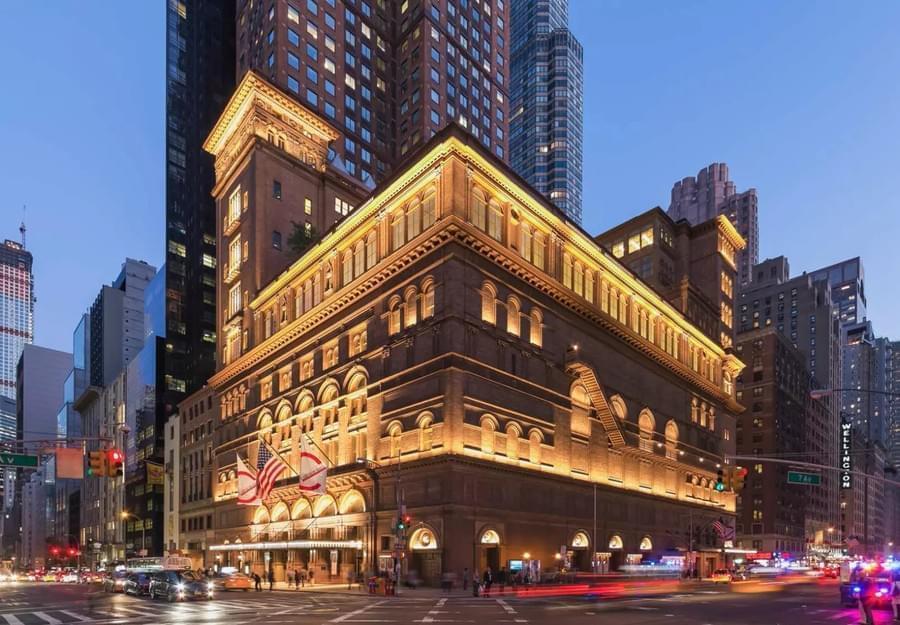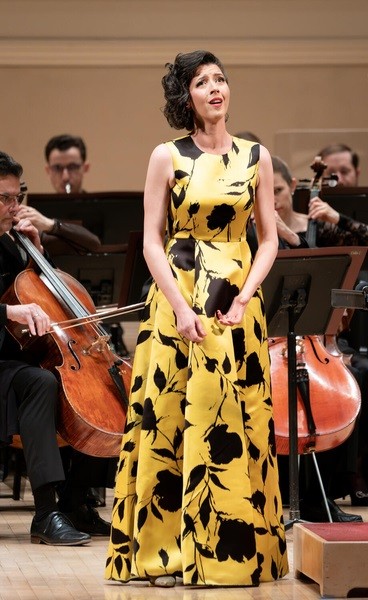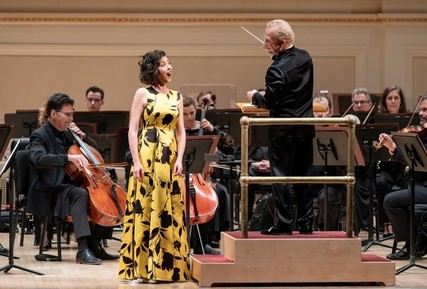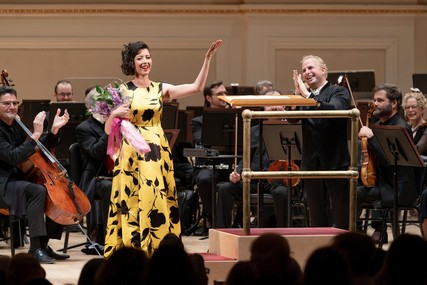Metropolitan Opera Orchestra Concert at Carnegie Hall
About
Experience the famous versatility of The Met Orchestra as Yannick Nézet-Séguin conducts Brahms’s First Symphony, two of Mozart’s great arias, and a recent work by one of today’s most celebrated composers. Jessie Montgomery’s unifying “Hymn for Everyone” came to her as a revelation—a rare sensation for the composer—and was premiered by the Chicago Symphony Orchestra in 2022. The agile voice of world-renowned soprano Lisette Oropesa shines in significant concert arias by Mozart. Grand in its scope as well as its themes, Brahms’s First Symphony is a heroic work, the culmination of decades of preparation and years of labor by a master.
Program
JESSIE MONTGOMERY "Hymn for Everyone"
MOZART "Vado, ma dove?," K. 583
MOZART "A Berenice … Sol nascente," K. 70
BRAHMS Symphony No. 1

🌷 Spring 2024 Newsletter
🌷 Spring 2024 Newsletter
Reviews
Night of the Queen of the Night
In her early Mozart aria A Berenice, Ms. Oropesa changed colors, played with the words, ripped up and down the scale like a marathon sprinter, and offered a rainbow-colored gift to us all.(By the way the story that A Berenice was the 13‑year‑old Mozart’s thank‑you letter to Aunt Berenice for a bar mitzvah gift is almost certainly fallacious.)This was Queen of the Night stuff incarnate. Coloratura, yes, with scales darting past a high D. Yet also tender, with a sensuous legato. Trills worthy of any Classical diva, precise leaps over the octaves. But above all, a care for the words, a change of sounds, a miraculous merger of vocalism and verbal understanding.None— Harry Rolnick • Concerto Net
Oropesa’s charm balances Brahms’ dark drama with Met Orchestra at Carnegie
Lisette Oropesa, who will join the Met forces on their Asian tour, last appeared at the Met as Gilda in Verdi’s Rigoletto in December 2022. Judging from the reception she received, the soprano has been greatly missed. Although this brief appearance singing two Mozart arias hardly sated her fans’ desire to hear more of her. The first of the two arias was “Vado, ma dové,” K. 583, which Mozart composed in 1789 for soprano Louise Villeneuve. Little is known of the soprano, except that she was the first Dorabella in Così fan tutte; Mozart write this insertion aria for Villeneuve to sing int Martín y Soler’s Il Burbero di Buon Cuore. Unsurprisingly, with the passage of time, Oropesa’s lyric coloratura soprano has grown in size and complexity. “Vado, ma dové” was less of a coloratura showpiece for Oropesa than an opportunity for her to display the beauty of her middle range. Her voice was especially creamy and rich in the second section of the aria in which she sang imploring for love to be her guide. Mozart composed “A Berenice – Sol nascente” K. 70 when he was only 13 as a birthday present to Prince-Archbishop Sigismund von Schrattenbach. The young genius found a congenial patron in the archbishop, as opposed to his successor Hieronymus Colleredo, who famously dismissed him from his service. “A Berenice – Sol nascente” is a licenza, as opposed to either a stand-alone aria or an insertion. Intended as an epilogue for Giuseppi Sarti’s opera-seria Vologeso, it opens with an extended recitative in praise of Prince Sigismund, which provided another opportunity for Oropesa to display the warmth of her middle register, as well as her flair for bringing words to life.None— Rick Perdian • New York Classical Review
Lisette Oropesa/MET Orchestra @ Carnegie Hall
From the moment she began to sing, it was evident that Lisette's is a perfect voice for Carnegie Hall. For some reason, the space is not that cordial to every voice, but Lisette sounded wonderfully vivid: it is a voice with great presence. In "Vado, ma dove?" the soprano displayed a blooming middle range and low notes of warmth and colour without being pushed. The clarity of tone, her expressive dynamic palette, and some gorgeous piani made the aria a treat to the ear. And her flawless breath control gave aria's final measures an impressive sustained quality. Mozart wrote "A Berenice...Sol nascente" at the age of 13. After a lively start comes a charming recitativo, followed by a long orchestra passage to introduce the aria proper, in which Lisette's fluency of coloratura was effortlessly displayed. A shift of mood leads on to one heavenly sustained tone and a delicious Oropesa trill.None— Oberon • Oberon's Grove
Lisette Oropesa shines radiantly in Mozart with the Met Orchestra at Carnegie Hall
With her lively and radiant lyric coloratura and formidable acting skills, Oropesa responded deftly to both the character and situation, sensitively conveying Lucilla’s confusion as well as her tenderness. Displaying extraordinary expressiveness, flexibility, and richness of color, Oropesa created a refined and deeply emotional interpretation of the scena. Singing with intensity and a rich, warm tone that perfectly supported the dramatic situation, she gracefully voiced the long legato lines and effortlessly negotiated the coloratura runs and trills.None— Susan Stempleski • Bachtrack
Review: Lisette Oropesa reappears at Carnegie Hall with the Met Orchestra
Soprano Lisette Oropesa then took the stage to perform two Mozart arias. The first, "Vado, ma dove?" K. 583, showed her ability to convey the fragility and emotional volatility of Lucilla, the character in the opera “ Il burbero di buon cuore” by the Spanish composer Martín y Soler. Oropesa, who continues to smooth out the rough edges of her vocal line and today offers a more refined and attentive singing, handled the flourishes of coloratura with enormous precision, without shortcuts or hiding places. In “A Berenice… Sol nascente,” K. 70, the soprano exhibited great vocal control in the recitative, flying over the Met Orchestra, and navigating with ease the technical demands of the aria. The Met musicians, following a very communicative Nézet-Séguin, gracefully drew the brilliance of the “rising sun” that Mozart so vividly illustrated in his music. Oropesa's interpretation of "A Berenice... Sol nascente," is perhaps superior to the version that was released on the album in 2021, perhaps more mature, and not only stood out for its technical skill, with splendid trills and scales, but also for its solid understanding of the text and music, doing justice to the work of a young Mozart. The singer was praised by the New York public, with four salutes, in an ovation that showed that Carnegie Hall was eager to hear Oropesa again.None— Carlos J. López Rayward • Opera World





